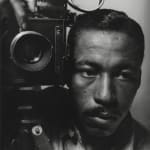


Gordon Parks
Untitled, 1941
gelatin silver print
24 x 20 in (61 x 50.8 cm)
28 7/8 x 26 in (73.2 x 65.9 cm), framed
28 7/8 x 26 in (73.2 x 65.9 cm), framed
Edition 2 of 10
©The Gordon Parks Foundation. Used with permission.
Further images
Gordon Parks (b. Fort Kansas, MI, 1912-2006) was one of the seminal figures of twentieth-century photography and a humanitarian deeply committed to social justice. As the first Black photographer for...
Gordon Parks (b. Fort Kansas, MI, 1912-2006) was one of the seminal figures of twentieth-century photography and a humanitarian deeply committed to social justice. As the first Black photographer for Life Magazine, he documented crucial aspects of American culture from the 1940s to 2006, focusing on race relations, poverty, civil rights, and urban life, often putting himself at risk to capture pivotal moments in history. In addition to his photography, Parks was a celebrated composer, author, and filmmaker, engaging with many leading figures of his era, from politicians and artists to athletes and celebrities.
Born into poverty and segregation in Fort Scott, Kansas, in 1912, Parks was drawn to photography as a young man when he saw images of migrant workers taken by Farm Security Administration (FSA) photographers in a magazine. He worked several odd jobs until he bought a camera at a Pawn Shop in 1937 in Seattle and was hired to photograph fashion at a department store in Minneapolis. Receiving the Julius Rosenwald Fellowship in 1942, Parks joined the FSA and later the Office of War Information. He freelanced for Vogue and published two books on photography, Flash Photography (1947) and Camera Portraits: Techniques and Principles of Documentary Portraiture (1948). In 1948, Parks was hired by Life Magazine where he began to chronicle the nation’s societal conditions beginning with his first story, a piece on the gang wars that were consuming Harlem in the late 1940s. Parks found success when he met Red Jackson, a young Black man who led a gang known as the Midtowners and used his camera as a means to reflect his own complex ambitions in hoping to both bring Harlem’s brutality to light and present young men in quiet, contemplative moments and in the blurred heat of savage brawls. Parks also gained access to the increasingly bellicose Black Muslim movement. When several white reporters were rebuffed in their requests for an audience with the group’s leaders, Parks—the only Black member of the magazine staff—was asked to try. During his investigations, he documented virtually every aspect of the Black Muslim community, in a full spectrum of images ranging from children and families at prayer to grown men exercising their physical strength in self-defense drills. Working for these agencies, Parks quickly developed a personal style that would make him among the most celebrated photographers of his era. His extraordinary pictures allowed him to break the color line in professional photography while he created remarkably expressive images that consistently explored the social and economic impact of poverty, racism, and other forms of discrimination. A true Renaissance man, Gordon Parks passed away in 2006.
Born into poverty and segregation in Fort Scott, Kansas, in 1912, Parks was drawn to photography as a young man when he saw images of migrant workers taken by Farm Security Administration (FSA) photographers in a magazine. He worked several odd jobs until he bought a camera at a Pawn Shop in 1937 in Seattle and was hired to photograph fashion at a department store in Minneapolis. Receiving the Julius Rosenwald Fellowship in 1942, Parks joined the FSA and later the Office of War Information. He freelanced for Vogue and published two books on photography, Flash Photography (1947) and Camera Portraits: Techniques and Principles of Documentary Portraiture (1948). In 1948, Parks was hired by Life Magazine where he began to chronicle the nation’s societal conditions beginning with his first story, a piece on the gang wars that were consuming Harlem in the late 1940s. Parks found success when he met Red Jackson, a young Black man who led a gang known as the Midtowners and used his camera as a means to reflect his own complex ambitions in hoping to both bring Harlem’s brutality to light and present young men in quiet, contemplative moments and in the blurred heat of savage brawls. Parks also gained access to the increasingly bellicose Black Muslim movement. When several white reporters were rebuffed in their requests for an audience with the group’s leaders, Parks—the only Black member of the magazine staff—was asked to try. During his investigations, he documented virtually every aspect of the Black Muslim community, in a full spectrum of images ranging from children and families at prayer to grown men exercising their physical strength in self-defense drills. Working for these agencies, Parks quickly developed a personal style that would make him among the most celebrated photographers of his era. His extraordinary pictures allowed him to break the color line in professional photography while he created remarkably expressive images that consistently explored the social and economic impact of poverty, racism, and other forms of discrimination. A true Renaissance man, Gordon Parks passed away in 2006.



